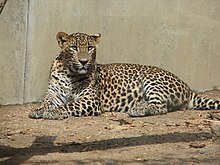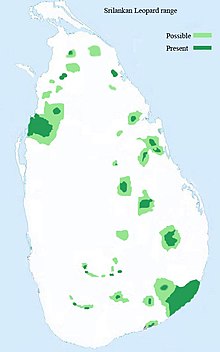Sri Lanka leopard
| Sri Lankan leopard | |
|---|---|
 |
|
| Sri Lankan leopard | |
| Scientific classification | |
| Kingdom: | Animalia |
| Phylum: | Chordata |
| Clade: | Synapsida |
| Class: | Mammalia |
| Order: | Carnivora |
| Suborder: | Feliformia |
| Family: | Felidae |
| Genus: | Panthera |
| Species: | P. pardus |
| Subspecies: | P. p. kotiya |
| Trinomial name | |
|
Panthera pardus kotiya Deraniyagala, 1956 |
|
 |
|
| Distribution of the Sri Lankan leopard | |
The Sri Lankan leopard (Panthera pardus kotiya) is a leopard subspecies native to Sri Lanka that was first described in 1956 by the Sri Lankan zoologist Deraniyagala.
In 2008, the Sri Lankan leopard was listed as Endangered on the IUCN Red List. The wild population is roughly estimated at 700–950 individuals as of 2015.
The Sri Lankan leopard has a tawny or rusty yellow coat with dark spots and close-set rosettes, which are smaller than in Indian leopards. Seven females measured in the early 20th century averaged a weight of 64 lb (29 kg) and had a mean head-to-body-length of 3 ft 5 in (1.04 m) with a 2 ft 6.5 in (77.5 cm) long tail, the largest being 3 ft 9 in (1.14 m) with a 2 ft 9 in (84 cm) long tail; 11 males averaged 124 lb (56 kg), the largest being 170 lb (77 kg), and measured 4 ft 2 in (1.27 m) with a 2 ft 10 in (86 cm) long tail, the largest being 4 ft 8 in (1.42 m) with a 3 ft 2 in (97 cm) long tail.
Sri Lankan leopards have historically been found in all habitats throughout the island. These habitat types can be broadly categorized into:
Leopards have been observed in dry evergreen monsoon forest, arid scrub jungle, low and upper highland forest, rainforest, and wet zone intermediate forests(1)
In 2001 to 2002, adult resident leopard density was estimated at 17.9 individuals per 100 km2 (39 sq mi) in Block I of Yala National Park in Sri Lanka’s southeastern coastal arid zone. This block encompasses 140 km2 (54 sq mi), contains sizeable coastal plains and permanent man-made and natural waterholes, which combined allow for a very high density of prey species.
The Wilpattu National Park is also known as a good place to watch leopards and currently a study is ongoing here conducted by The Leopard Project of The Wilderness and Wildlife Conservation Trust (WWCT).
A study in Yala National Park indicates that Sri Lankan leopards are not any more social than other leopard subspecies. They are solitary hunters, with the exception of females with young. Both sexes live in overlapping territories with the ranges of males overlapping the smaller ranges of several females, as well as overlapping the ranges of neighbouring males. They prefer hunting at night, but are also active during dawn and dusk, and daytime hours. They rarely haul their kills into trees, which is likely due to the lack of competition and the relative abundance of prey. Since leopards are the apex predators they don't need to protect their prey.
...
Wikipedia

